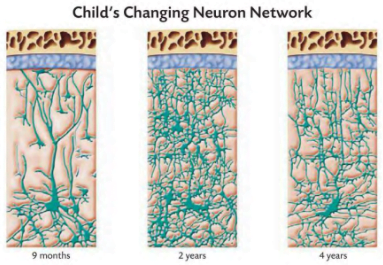DEVELOPMENT RATES / GENDER DIFFERENCES / GAINING CONTROL ( WAVES OF CHANGES – AN ADOLESCENT BRAIN )
DEVELOPMENT RATES
As the child grows into an adolescent, different regions of the brain develop at different rates. For example, the regions that govern reflexes and the ability to process new information are as mature in a teenager’s brain as in that of an adult. Teenagers learn facts quickly but often forget them just as easily.
Their brain still is in its peak learning time, like that of children, but not yet fully developed, like that of adults. A mature brain makes strong connections, starting at the back of the head and working its way toward the front, as myelin gets laid down over neural networks to make them conduct signals more quickly.
The last place to be fully covered in myelin is the prefrontal cortex in the adult brain. Thus, while the adult brain may lack the learning power of a teenager’s brain, it typically makes up for it with faster, sharper judgement in the frontal lobes.
GENDER DIFFERENCES
Boys’ and girls’ brains mature at different rates. Girls typically are a year or two ahead of boys in the timing of their myelination. The brain in boys finishes laying down myelin when they are in their late teens and early 20s, while that of girls completes the job in the mid to late teenage years.
Some observers have said that might be a good reason to teach academic subjects earlier to teenage girls than to teenage boys. Others, however, say that because brains vary not only between the sexes but dramatically among individuals, the best instruction ideally would be tailored to each student.
GAINING CONTROL
Control of physical movements is nearly complete among adolescents. A teenager may have an adult’s command of the physical skills of basketball or tennis. However, the regions of the brain that control emotions may still be under development in the teenager’s brain. Small wonder, then, that a young athlete may be able to hit a golf ball 250 yards yet struggle to avoid an emotional eruption when it slices into the woods.
During adolescence, neurons create connections that may last a lifetime. But they do so in an environment where the hormones of puberty change the cellular structure of brain and body. The result is a volatile time of brain development that matches the chaos of the body’s adolescent years.
Take just the gray matter the neurons as an example. Neuroscientists at the National Institute of Mental Health (NIMH) in Bethesda, Maryland, found surprising changes in preadolescent and adolescent brains when they performed a series of MRI scans in the 1990s and first decade of the 21st century.
While white matter stayed nearly constant over the age range, the volume of gray matter underwent two shifts-increasing toward the end of childhood, and then decreasing with the onset of adolescence. The researchers believe the brain undergoes a wave of neuronal connections around age 11 in girls and 12 in boys, followed by a wave of pruning. It’s as if a plant sent out too many roots, and then let die the ones that failed to find water.

Jay Giedd of NIMH described the adolescent brain as follows: “There’s an enormous potential for change through the teen years. And this is great because those years are a time when choices have to be made and skills acquired as adolescents learn how to adapt to their environment.
During the process, adolescents must learn to gain control over their sexual and aggressive impulses, adapt their behavior to the reasonable expectations of parents and teachers, accept authority, and generally get along with others.”


